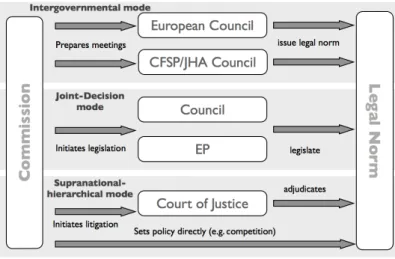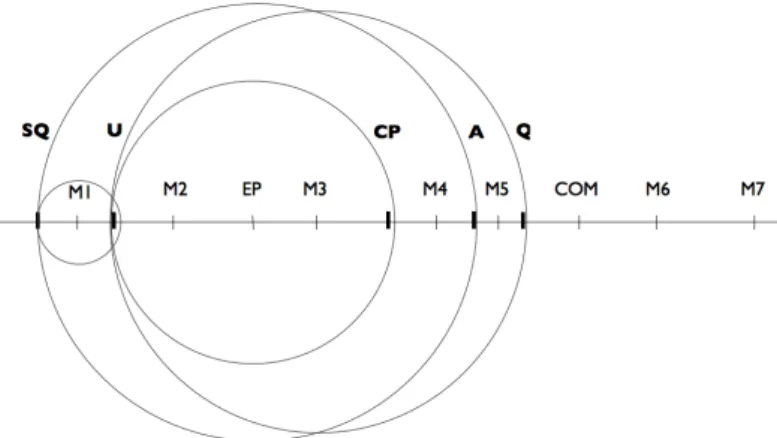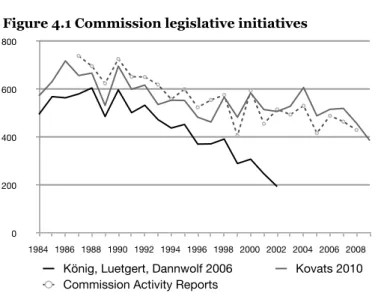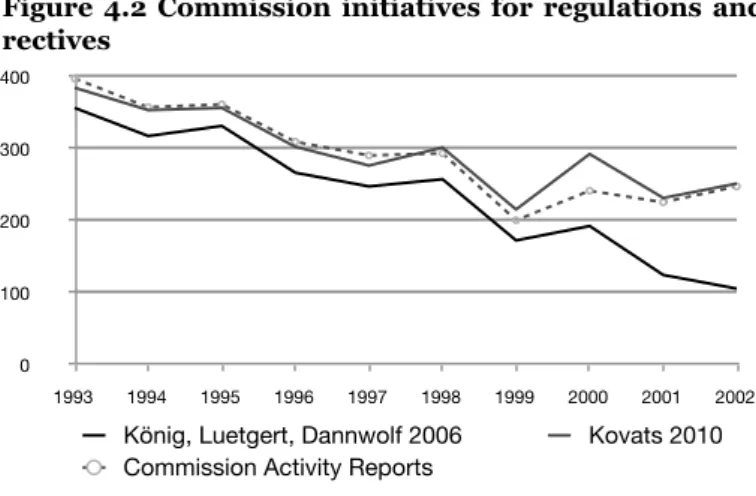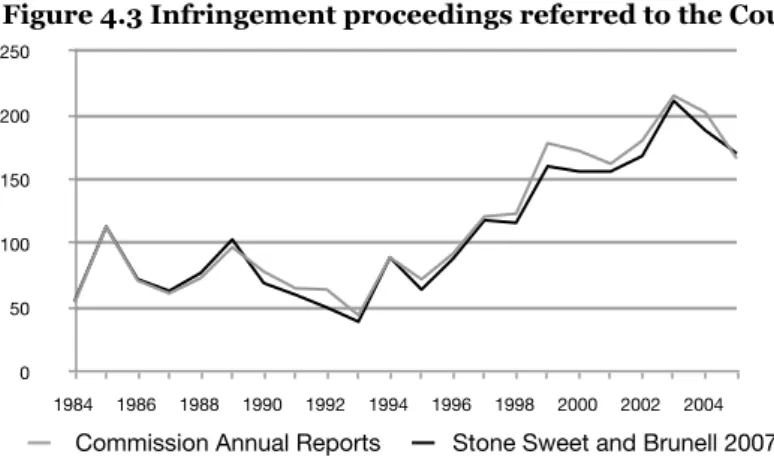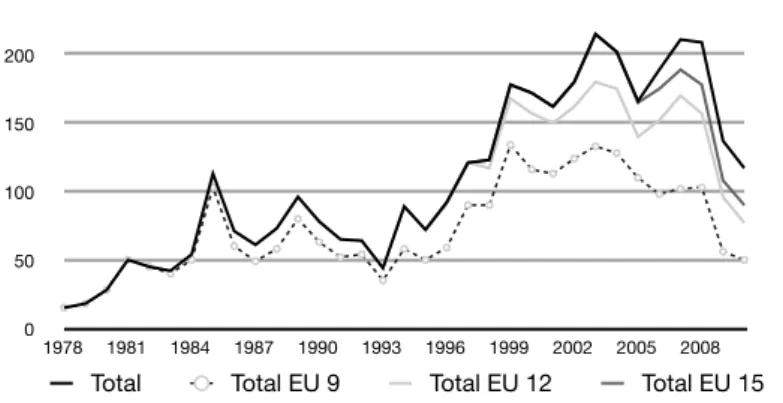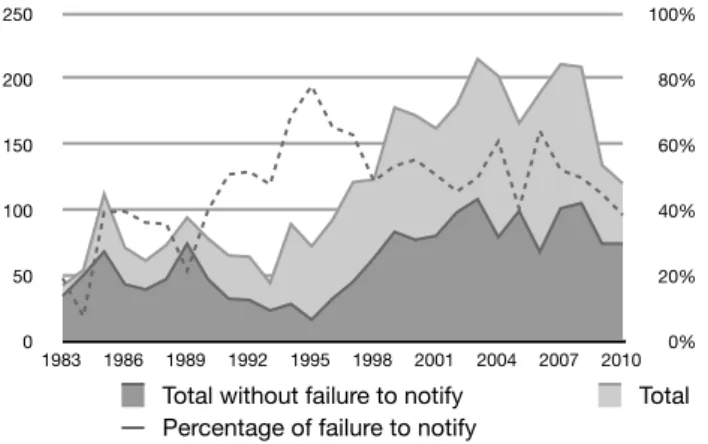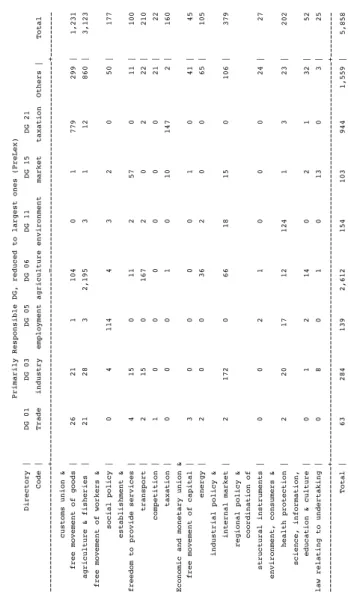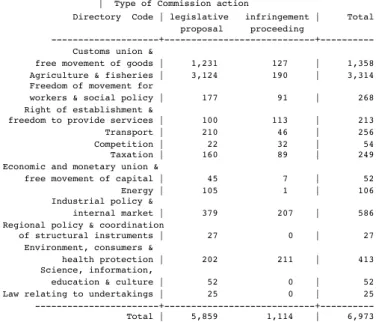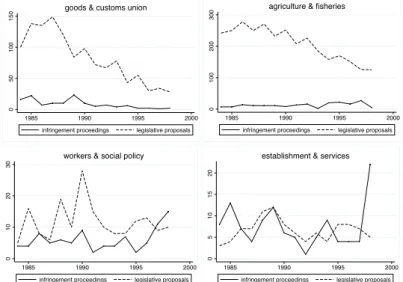Andreas Hofmann
Strategies of the Repeat Player The European Commission between Courtroom and Legislature
Strategies of the Repeat Player The European Commission between
Courtroom and Legislature
Inauguraldissertation zur
Erlangung des Doktorgrades der
Wirtschafts- und Sozialwissenschaftlichen Fakultät der
Universität zu Köln 2012 vorgelegt
von
Magister Artium Andreas Hofmann aus
Düsseldorf
Koreferent: Prof. Dr. André Kaiser Tag der Promotion: 14. Dezember 2012
Für meine Eltern
Contents
Preface xi
Introduction 1
1.1 Judicial politics in the European Union 7
1.2 The structure of my study 11
Studying the European Commission 18 2.1 The European Commission in the study of European Union
politics 18
2.2 Who is ‘the Commission’ and what does it want? 32 The European Commission in the policy-making
process 43
3.1 Modes of policy-making 43
3.2 The Commission and the intergovernmental mode 52 3.3 The Commission and the joint-decision mode 57 3.4 The Commission and the supranational-hierarchical mode 66 3.5 Comparing the Commission’s position in the three policy
modes 92
Predicting strategy choice 95
4.1 A default strategy 95
4.2 Factors influencing the Commission’s choice of strategy 99
4.3 Data 101
4.4 Results and discussion 133
Removing barriers to trade 138
5.1 Overview 139
5.2 Quantitative restrictions and measures having equal effect 141
trade 158 5.4 Mutual recognition and the single market programme 178
5.5 Mutual recognition after 1992 186
5.6 Conclusion 193
From market citizen to European citizen 200
6.1 Overview 201
6.2 Cooperation and emerging friction 204 6.3 Moving beyond the economic base of free movement 213 6.4 Towards a general right of residence 219 6.5 Defining the substance of European citizenship 233
6.6 Conclusion 241
Conclusions 247
7.1 Reviewing my hypotheses 249
7.2 Preliminary references and judicial strategy 254 7.3 Some thoughts on the wider legal environment 257
Bibliography 261
Figures and Tables
Figures
3.1 Commission strategies in three modes of policy-making 47
3.2 Agenda setting in EU legislation 61
4.1 Commission legislative initiatives 104 4.2 Commission initiatives for regulations and directives 105 4.3 Infringement proceedings referred to the Court 108 4.4 Infringement proceedings referred to the Court – by accession
round 109
4.5 Infringement proceedings referred to the Court – by subject
matter 110
4.6 Infringement proceedings referred to the Court and legislative
proposals 116
4.7 Mean of dependent variable over time 119 4.8 Mean of variables EP veto ad Council voting rule over time 124 4.9 Mean of variables controversy and prevalence of directives
over time 127
4.10 EU legislative institutions’ mean party political position on a
left-right scale 129
4.11 Annual absolute ideological distance between EU legislative
institutions 130
5.1 Legislative initiatives and cases referred to the Court 195 6.1 Legislative initiatives and cases referred to the Court 244
Tables
4.1 Cross-tabulation of policy field and responsible DG 114 4.2 Type of Commission action by policy field 115 4.3 Information on Council voting rule 121
4.5 Descriptive statistics on all variables in the analysis 132 4.6 Results of OLS regression (with time fixed effects) 134
Preface
One of the startling empirical insights from the growing body of research on the workings of the EU judicial system is that the European Commission almost always wins. This finding is remarkably robust – every empirical study I am aware of that deals with success and failure in proceedings before the European Court of Justice has so far replicated this result.
Whether the Commission litigates itself or lodges an ‘obser- vation‘ (a legal brief outlining its position) in a case brought by a different party, the Court follows the Commission’s opinion in the vast majority of cases. Since empirical data on judicial behaviour at the Court of Justice is sparse – judges do not publish votes or record dissents – the source of this
‘special rapport’ is difficult to establish. But whatever the reason may be, it seemed to me that this crucial ‘asset’ would have to have some bearing on the Commission’s overall stance in the EU’s policy-making process. Since the Court has been the author of so many ‘history-making’ decisions shaping the content of EU policies, being a frequent and fre- quently successful litigator should provide the Commission with an alternative means of achieving policy objectives, at least when all else fails. Hence, this book looks at how the Commission makes use of its ‘special rapport’ with the Court of Justice and what factors influence its use of court proceed- ings vis-à-vis its alternatives in shaping EU policy. In pursu- ing these questions, I am hoping not only to learn more about the interaction of different modes of EU policy- making, but also to contribute to a body of research that takes a less ‘court-centric’ approach to ‘law and politics’ in the EU. Like all courts, the European Court of Justice needs to be ‘activated’ by litigants pursuing their interests couched in legal terms. Learning more about the motives of litigants, their alternatives to litigation, and their reasons for choosing
this course of action should contribute to a better under- standing of the political relevance of the legal system.
Looking back at the long process of which this publication is a preliminary culmination, I realise that I am indebted to many sources of inspiration and support, only some of which I can actually name. First of all I would like to thank my the- sis supervisor, Professor Wolfgang Wessels, who both sup- ported my fixation on the Commission and the Court and urged me to maintain a broader interest in EU politics. I would further like to thank Professor André Kaiser, whose seminar on constitutional courts in established democracies provided the nucleus of my idea for this study, and Professor Ingo Rohlfing for making me much more self-conscious about methodology. Between 2010 and 2011, I had the good fortune to be able to spend some time as visiting graduate student at the University of Chicago, where I learned a great deal about the state of research on ‘law and politics’. I am greatly indebted to Professor Gerald Rosenberg, first for giv- ing me this opportunity, and second for making me think much more broadly about the role of courts in society. I would also like to thank Professor Susanne Schmidt for her support of my work, which borrows many insights from hers.
Anette Fasang patiently answered my many questions about the appropriate use of statistics, and I am very grateful for her help. Naturally, she bears no responsibility for the re- maining defects.
My deepest gratitude goes to Franzi Bedorf, who not only read the entire manuscript, but endured my increasingly er- ratic schedule and supported me at every step. Thank you so much for being part of my life.
Finally, I dedicate this book to my parents, Gabriele and Joachim Hofmann, whose unconditional support made all this possible.
Chapter 1
Introduction
When Duke Wilhelm IV of Bavaria decreed a purity law for beer on April 23, 1516, he had in mind a late medieval equivalent of consumer protection. Knowledge about the bio- logical details of the fermentation process was not widely available, and many contemporary beers must have tasted quite foul, particularly during the summer, when high tem- peratures frequently caused brews to go off. Since beer was still preferable to unsanitary fresh water, and its production lucrative business, brewers frequently made use of all sorts of questionable and not rarely toxic additives to cover up the off-tastes of their products. The more fanciful of these in- cluded fly agaric mushrooms, ivy, chalk, soot, snake juice and oxen bile (cf. Thomas 2006: 32; Dornbusch 2011: 104-105).
To reign in such creativity, Wilhelm IV’s decree restricted the ingredients allowed in the brewing process to barley, hops and water.1
Originally only a Bavarian statute, it was not until four cen- turies later that the German Reichstag established the purity law as a nation-wide rule, in 1906, much to the detriment of some northern German brewing traditions that had included various herbs and spices to vary the flavour of their product (cf. Thomas 2006: 32). The term ‘Reinheitsgebot’, as the law is known today, was coined shortly thereafter, in the wake of the foundation of the first German republic in 1919. Bavarian delegates used the term in their insistence that the Bavarian law remain the law of all of Germany, in which they suc-
1 Yeast was not included in the original list since its properties were un- known at the time. The use of malted wheat for wheat beers was reserved for families of the nobility, and subsequently became a very lucrative niche (Dornbusch and Oliver 2011: 829).
ceeded – the newly assembled Reichstag retained the prior
‘Biersteuergesetz’ codifying the purity law. By the time it celebrated its 450 year anniversary, the purity law was con- sidered the world’s oldest continuously existing food quality standard (cf. Dornbusch and Heyse 2011: 692).
Sometime in late 1981, a German distributor announced to the French brewery Brasserie du Pêcheur, based in Schil- tigheim in Alsace, that it would cease to carry its products.
German authorities had repeatedly removed Brasserie du Pêcheur beers from retail shelves, on the grounds that the Brasserie’s use of additives in the brewing process ran afoul of Germany’s most recent codification of the purity law, the revised Biersteuergesetz of 1952, which allowed for bottom fermenting beers such as the Brasserie’s only the use of malted barley, hops, yeast and water. Products that con- tained other ingredients could not be sold in Germany as
‘beer’. Excluded from the lucrative German beer market, the Brasserie du Pêcheur complained to the European Commis- sion. In restricting its market to beers brewed according to the purity laws, it argued, Germany was infringing the Euro- pean Community’s free market principles, in particular Arti- cle 30 of the EEC Treaty, which forbade quantitative restric- tions to trade, and all measures having equivalent effect (cf.
Clark 1988: 769-770).
The removal of such barriers to trade had been a priority of the Commission for quite some time. Its principal approach to this issue throughout the 1960s and 1970s had been to propose legislation introducing common product standards that would preclude member states from applying their own rules to imported products. This process was cumbersome, due on one hand to the complicated nature of detailed stan- dards and the constant need to update rules to technological progress, and on the other to decision-making rules that gave every member state a veto over individual pieces of legisla-
tion. Product standards can serve ambiguous purposes; they are obviously necessary to protect consumers and the envi- ronment, but they can also be a subtle form of protectionism, especially where a certain standard is basically a codification of prevalent practices in one country, drawn up by the lead- ing domestic producers. It is not entirely surprising that member state governments were reluctant to relinquish such standards, especially where they affected important domestic industries.
Among the pieces of legislation proposed by the Commission in the field of product standards had been one concerning the characteristics of beer produced within the Community (OJ 1972, No. C 105/17). It suggested that European stan- dards on the content of beers follow the example of French laws, which allowed the use of up to 30 percent of raw mate- rials other than malted barley or wheat for the production of fermentable wort.2 That piece of legislation, and subsequent amendments, went nowhere in the Council, owing mainly to resistance by the German government (cf. Schweitzer and Streinz 1984: 42).
By the time the Brasserie du Pêcheur lodged its complaint, the Commission had announced a change of strategy. Rather than introduce more legislation, the Commission would rely on existing laws on the free movement of goods, as it itself interpreted them, and bring enforcement actions before the Court of Justice where such laws were infringed by member states. The Court of Justice’s recent case law had proven fa- vourable to this approach, with a long series of cases, most notably Dassonville (Case 8/74, ECR 1974: 838) and Cassis de Dijon (Case 120/78, ECR 1979: 650),3 restricting member state discretion to autonomously regulate trade. Prior to the
Introduction 3
2 Cf. “Eurobrew”, The Economist, 29 December 1973, Survey, p. 10.
3 Cf. chapter 5.
beer purity law case, the Commission had taken the Italian government to court for restricting the designation ‘aceto’
(vinegar) to products derived from wine (Case 2193/80, ECR 1981: 3019). The Court supported the Commission’s position that this was an illegal restriction to trade, as products made from other raw materials, like apple must or malt, could freely be marketed as ‘vinegar’ in other member states. The analogy to beer is obvious, but the German beer case was special, as it affected both the largest member state and one of its most coveted products, protected by a rule that dated back almost half a millennium. The German beer market in the 1980s was second only to the US in both production and revenue, and Germans consumed an annual average of about 150 litres per head (240 litres in Bavaria), by far the highest rate of consumption in the EEC (cf. Schweitzer and Streinz 1984: 47).4 In fact, the German government claimed that beer was the single most consumed foodstuff in Germany, and its protection warranted particular measures (Case 178/
84, ECR 1987: 1236-1237, German edition). The German laws, which effectively functioned as an import ban on non- Reinheitsgebot beers, helped secure domestic producers a market share of about 99 percent (cf. Kohler 1987: 13; Pal- trow 1987).
Following its revised strategy, the Commission took no heed of German protestations and initiated an infringement pro- cedure against Germany with a formal letter to the German government in February 1982. Since no agreement could be reached in the early stages of the procedure, the Commission referred the case to the Court of Justice in July 1984. (Inci- dentally, the Commission opened parallel proceedings against Greece, the only other European country with a pu- rity law for beer, the Greek king Otto, who decreed it during
4 Cf. also “Bier - hierzulande mehr als ein Getränk”, Frankfurter Allgemeine Zeitung, 2 February 1986, p. B5.
his reign from 1832-1862, having been of Bavarian origin.)5 The Commission argued that the German laws distorted trade in two ways. First, by banning the import of non- Reinheitsgebot beers, it protected its domestic market from foreign competition. Second, by exempting from the Rein- heitsgebot beers brewed in Germany exclusively for export, it simultaneously allowed German brewers to compete on the world market. By virtue of this ostensibly protectionist regu- lation, German exports of beer exceeded imports by a factor of four to one (Case 178/84, ECR 1987: 1234, German edi- tion). Moreover, the Commission argued that the import ban on non-Reinheitsgebot beers could not be justified on grounds of consumer protection. Even where the prohibited raw materials and additives commonly used in foreign beers may constitute health risks, these same substances could le- gally be used in the production of other foodstuffs in Ger- many, most notably in wine (Case 178/84, ECR 1987: 1236, German edition).6 In the Commission’s view, there was therefore no reason that beer that could be legally be in other member states should not also be sold in Germany.
In its reply, the German government argued that in the ab- sence of harmonizing legislation, member states retain the right to autonomously regulate their domestic markets. As long as this was so, different national regulations of necessity lead to trade barriers, but these could only be addressed by Community legislation (Case 178/84, ECR 1987: 1235, Ger- man edition). Following the Commission’s opinion would moreover lead to a dangerous increase in the consumption of additives, as every state would have to adapt its legislation to
Introduction 5
5 Greek beers not being known for their excellence, some observers view this as evidence falsifying the assumption that a purity law is a sufficient condi- tion for high quality beers. A trip to Belgium may also convince that neither is it a necessary one.
6 The German Association of Consumer Organizations quipped that ''The only ingredient in domestic and foreign beer that has so far been proven to be potentially damaging is alcohol'' (Quoted in Markham 1987: A7).
the position of the most lenient member state (Case 178/84, ECR 1987: 1240, German edition). Finally, it argued that the concept of ‘beer’ was “inseparably linked” to the Reinheitsge- bot in the mind of he German consumer, so that for the sake of consumer protection any product differently produced should not carry that designation (Case 178/84, ECR 1987:
1270).
The Court did not accept the German government’s argu- ments. To the latter, it replied that consumer concepts of products evolve over time and that such an evolution must not be precluded by marketing regulations. Quoting an ear- lier judgement, the judges stated that “the legislation of a Member State must not 'crystallize given consumer habits so as to consolidate an advantage acquired by national indus- tries concerned to comply with them'” (Case 178/84, ECR 1987: 1270-1271). Rather than a ban on imports, a simple labeling requirement would sufficiently serve the purpose of consumer protection in this regard. Moreover, the Court did not follow the German government’s interpretation of the discretion available to national governments in regulating domestic markets where there was no common Community legislation. While it agreed that, in the absence of harmoniza- tion, member states retained some regulatory powers, these, it said, may not be used to pursue unjustified goals, or, where goals such as public health and consumer protection are jus- tified, result in measures that go beyond what is necessary to attain these goals. Consequently, it concluded that “in so far as the German rules on additives in beer entail a general ban on additives, their application to beers imported from other Member States is contrary to the requirements of Commu- nity law as laid down in the case-law of the Court, since that prohibition is contrary to the principle of proportionality”
(Case 178/84, ECR 1987: 1276).
Another precedence was set, and the Commission could claim an essential vindication of its new, judicial, strategy to remove barriers to trade within the Community, following the principle that a product lawfully produced and marketed in one member state should equally be marketable in all other member states. After its initial legislative strategy had failed, the Commission initiated judicial proceedings, seizing upon legal innovations, and succeeded in establishing a prin- ciple that allowed it forthwith to minimize its legislative ac- tivity to cover only minimum standards that member states could more easily agree on.
This Commission strategy, this interplay between legislative politics and the judicial sphere is what this book is about.
What I attempt is to provide a more inclusive picture of how the European Commission acts within the policy process, a picture that spans various modes of producing policy and indicates which factors account for the choice of strategy. In short, I want to systematically explore a connection between judicial and legislative politics that has as yet not been exten- sively addressed (cf. Schmidt 2011a: 43; Schmidt 2011b: 37).
1.1 Judicial politics in the European Union
The proximity of law and politics in the European Union, as demonstrated by the Reinheitsgebot case, has certainly not escaped the attention of observers from the social sciences, although they have been late in catching on to the connec- tion. The central legal principles had all been long estab- lished when political scientists began debating the role of the European Court of Justice in EU politics. Early debates cen- tred around the question if the Court independently set poli- cies, or whether it was influenced significantly by the prefer- ences of the largest member states (cf. Burley 1993; Burley and Mattli 1993; Garrett 1995; Mattli and Slaughter 1995;
Alter 1998; Garrett, Kelemen et al. 1998; Mattli and Slaugh-
Introduction 7
ter 1998; Stone Sweet and Brunell 1998). A satisfying empiri- cal answer to this question proved elusive, not least because data on judicial decision-making in the Court of Justice was lacking (cf. Scharpf 2011: 229). The judges do not publish their ‘votes’, and there are no dissents or concurring opin- ions. Although for this reason the question was never conclu- sively settled, some central insights emerged. For one, the Court appears to act strategically. The more member states argue for a specific norm, the less likely the Court is to strike it down, although the Court shows no preference for the posi- tion of large over small states (cf. Conant 2007: 51). On the other hand, the most successful litigant before the Court is not a member state, but the European Commission; it wins the overwhelming majority of the cases it argues (cf. Conant 2007: 53).
The new found attention to the judicial sphere of European Union politics spawned a whole range of research questions that went beyond the sole issue of the Court’s independence, and sought to locate the legal system in the broader political context. Gradually, the focus shifted away from the Court of Justice as the focal institution to the wider legal environ- ment, including the role of national courts in the evolution of EU politics (cf. Slaughter, Stone Sweet et al. 1998), and the position of individual litigants and the goals they wish to pursue through litigation. A significant part of the latter lit- erature looks at the way the European legal system empow- ers individuals to challenge the domestic status quo (cf. Alter and Vargas 2000; Cichowski 2006; Kelemen 2006). Daniel Kelemen’s recent book-length study of the evolving legal in- frastructure in the European Union points to an increasingly adversarial system of confrontation between regulators and the regulated claiming rights derived from the EU legal sys- tem, a process that he considers akin to American forms of regulatory politics and dispute resolution, away from more inclusive corporatist structures formerly prevalent through-
out Europe (Kelemen 2011: 4-7). Many such studies are keenly aware that this empowerment does not affect all ac- tors equally, but favours strong organised interests over indi- viduals who either cannot muster the resources to initiate the legal process or are unaware of their rights (cf. Alter and Vargas 2000; Börzel 2006). In particular, actors who fre- quently engage in litigation, so called ‘repeat players’ (cf.
Galanter 1974), enjoy specific advantages in the long run, being able to ‘play for the rules’: they can discount the costs of individual judgements against future rewards where they succeed in establishing legal principles that enhance their overall position. The European Commission is surely the sin- gle most frequent litigator before the Court of Justice, and the prototypical repeat player on the European legal stage.
Comparatively few works have sought to combine a focus on judicial politics with policies pursued in other spheres. An early example of such an approach is Karen Alter and Sophie Meunier Aitsahalia’s article on the impact of the Court’s im- portant ruling in the Cassis de Dijon case, which laid out the groundwork for the principle of ‘mutual recognition’ (Alter and Meunier Aitsahalia 1994). They investigate how the Court’s judgement, by altering the status quo with regard to permissible trade barriers, provided novel opportunities for various individual and institutional actors to pursue their preferences in national and European fora. In particular, they demonstrate how the Commission seized upon the newly formulated doctrine and used it as a basis for a new approach to remove intra-European trade barriers. While Alter and Meunier bridge the gap between the judicial branch and other spheres of action, theirs is foremost a study of how organisations such as the Commission react to Court rulings they can use to their advantage. Judicial processes, however, can be strategically induced. Individuals can chal- lenge national norms in national courts, and the Commission
Introduction 9
can litigate against member states before the Court of Jus- tice, all in order to influence policy.
The Commission’s use of the infringement procedure has been closely scrutinised in studies focussing on the national implementation of EU legislative acts (cf. Mendrinou 1996;
Börzel 2001; Panke 2009; Börzel, Hofmann et al. 2012). As a result, there is a rich body of insights about what factors in- fluence the distribution of infringement proceedings across member states. Prominent among these are national gov- ernments’ administrative capacity and political clout (cf.
Börzel, Hofmann et al. 2010: 1381). However, these studies rarely address the policy consequences that judicial proceed- ings entail. In focussing on national compliance, they de- emphasise the conflicts over policy content that are fought out before the Court of Justice and their implications for fu- ture policy-making.
The way the Commission can employ its enforcement powers to influence legislative processes has been explored in the works of Susanne Schmidt. She demonstrates the intercon- nectedness between litigation and legislation by focussing on the Commission’s ability to strategically alter the status quo of legislative procedures through enforcement actions before the Court of Justice. In particular, she outlines two courses of action the Commission takes in order to apply pressure on Council positions. One targets the status quo of legislation as a whole, by threatening judicial procedures with an outcome potentially disliked by all Council members. The other strat- egy consists of targeting individual member states, particu- larly those pivotal in majority voting. Based on these in- sights, Fritz Scharpf feels confident to declare that “the Commission is able to use infringement and annulment pro- ceedings in order to place specific issues on the Court’s agenda, and there is no question that it is able to use its power strategically in order to influence the outcome of legis- lative processes in the Council” (Scharpf 2011: 229-230).
My study takes these insights as a starting point to system- atically assess how the Commission makes use of its access to legislation and litigation in order to advance its policy inter- ests. My contribution is twofold. On the one hand, I aim to analyse what variables influence the Commission’s decision to resort to infringement proceedings when pursuing policy.
I start from the assumption that the Commission is more likely to pursue a judicial strategy when the obstacles to suc- cessful legislation are high. I test this proposition with the help of a dataset that combines information on legislative processes, infringement proceedings and the political posi- tions of the actors involved. On the other hand, I expand this approach beyond the focus on infringement proceedings to the Commission’s use of litigation in general in two longitu- dinal case studies. While Susanne Schmidt argues that in- fringement proceedings are “the most decisive means for the interaction of judicial and legislative politics” (cf. Schmidt 2011a: 50), I aim to show that other forms of litigation, in particular the Commission’s intervention in preliminary ref- erence procedures, also present viable channels of combining the two modes of policy-making. In essence, I incorporate a judicial politics approach in an overall analysis of policy- making in an attempt to achieve a more comprehensive pic- ture of how the Commission influences policy development in the European Union.
1.2 The structure of my study
I structure my study in the following way. Chapter 2 provides an overview of theoretical approaches to the Commission’s position in the policy-making process of the European Un- ion. The question of how much the Commission matters has traditionally formed one of the focal points of theorising the dynamics of European integration. I trace the ebb and flow of scientific attention to this topic, which has been closely linked to actual successes and failures of the European politi-
Introduction 11
cal system, and outline the central tenets of the opposing camps. I describe how in more recent time the focus of theo- retical approaches has moved away from dynamic accounts of the integration process to a more cross-sectional, com- parative outlook on the constraints of policy-making. Rather than aligning squarely with the traditional factions of neo- functionalism and intergovernmentalism, these newer ap- proaches analyse the factors and circumstances that allow the Commission to influence policy content in some in- stances, and prevent it from doing so in others. I highlight two approaches, the ‘agenda-setting’ literature and the
‘principal-agent’ approach, as particularly conducive to a more detailed understanding of the Commission’s position in European politics. Chapter 2 moreover reviews theoretical assumptions and empirical findings concerning the Commis- sion’s ‘actorness’. I start by outlining the ‘traditional’ aca- demic assumptions on the type of preferences the Commis- sion pursues. Until quite recently, the Commission was regu- larly treated as a preference outlier, usually with an ‘extreme’
disposition towards ‘more integration’, however defined.
Some explanatory approaches draw on ‘bureaucratic politics’, positing that the Commission’s preferences are a conse- quence of organisational self-interest. I contrast these as- sumption with more recent empirical data on internal pref- erence distributions and decision-making dynamics. These newer accounts challenge the assumptions that the Commis- sion necessarily pursues ‘more extreme’ preferences than the member states, and that it can be treated as a unitary actor.
Rather, such studies demonstrate distinct clusters of prefer- ences across services, and point to procedural structures that systematically favour certain internal departments, in par- ticular the respective lead Directorate General (DG) and the Secretariat General. I conclude by outlining which of these insights can fruitfully inform my approach to Commission strategy choice.
Chapter 3 outlines the Commission’s position in the inter- institutional policy-making process. I distinguish between three different modes of policy-making that share the pro- duction of legal norms as output (cf. Scharpf 2006): an inter- governmental mode, characterised by bargaining between member state governments, a ‘joint-decision’ mode, charac- terised by the Commission’s monopoly of initiative in legisla- tion, and a ‘supranational-hierarchical mode’, characterised by the Commission’s ability to influence policy without the involvement of the legislative institutions, by executive ac- tion and initiating court proceedings. Each of these modes affords the Commission different degrees of influence over policy production, and I discuss the various constraints on Commission policy-making strategies in some detail. On one end of the scale, the Commission’s ability to influence out- comes is weakest in situations of intergovernmental bargain- ing. On the other end, its policy-making ability is greatest in those areas where it has been delegated extensive executive authority. This is primarily so in the field of competition pol- icy, including the contentious areas of state-aid and public utilities. While the Commission has the ability to act unilat- erally, its authority is at the same time closely circumscribed to a limited policy field. The Commission’s ability to influ- ence the policy process is broadest in legislation and litiga- tion – the content of legislative initiatives and court cases being barely limited in scope. I conclude the chapter by justi- fying my choice to concentrate on the latter strategies for the remainder of my study.
The following three chapters constitute the empirical part of this study. I proceed by developing a series of propositions which I first test statistically (chapter 4), and then follow up with two longitudinal case studies (chapters 5 and 6). This mixed method design is akin to a “nested analysis” (cf. Lie- berman 2005; Rohlfing 2008), although I do not claim to follow the model rigorously. My strategy is to start with strict
Introduction 13
assumptions derived from previous works, and then, based on the results of the statistical test, use case studies to add complexity and derive additional insights. The case studies therefore have both a hypothesis-testing and a hypothesis- generating aspect. They provide additional empirical mate- rial to test prior assumptions against observed reality, and their results serve to further refine the theory (cf. Levy 2008:
5).
Chapter 4 concentrates on the Commission’s use of in- fringement proceedings as a policy tool. I develop assump- tions about the Commission’s default strategy in policy- making and formulate a series of hypotheses about the fac- tors that are likely to influence the Commission’s subsequent strategy choice. In particular, I propose that the Commission is more likely to resort to infringement proceedings when the likelihood of initiating successful legislation is low. This is the case where voting rules in the Council stipulate unanim- ity, and where the European Parliament has veto powers.
Obstacles to legislation should also rise, the larger the ideo- logical difference between the Commission and the Council and the Commission and the EP, respectively, and in situa- tions where there is considerable disagreement within the Council. I also include a control variable that measures the degree of ‘market orientation’ of a policy area. This allows me, to some degree, to respond to the frequently voiced proposition that judicial politics in the EU has a distinctly market-making bias (cf. Scharpf 2006: 854). It moreover enables me to draw some, albeit limited, conclusions about possible internal differences in strategy choice between Commission portfolios generally held to pursue a form of interventionist ‘regulatory capitalism’ and more market ori- ented portfolios (cf. Hartlapp and Lorenz 2012: 11). I then proceed to test these propositions employing a dataset I have constructed from data based on three different sources. One is a dataset on legislative procedures, compiled by Thomas König, Brooke Luetgert and Tanja Dannwolf (König, Luetgert
et al. 2006). I combine this dataset with information on in- fringement proceedings referred to the Court by the Com- mission, based on data compiled by Alec Stone Sweet and Thomas Brunell (Stone Sweet and Brunell 2007). Addition- ally, I use data on the ideological positions of the Commis- sion, the Council and the European Parliament, as compiled by Andreas Warntjen, Simon Hix and Christophe Crombez (Warntjen, Hix et al. 2008). I designed my dataset so that the dependent variable is the ratio of litigation to legislation in a particular policy area across time. The dearth of available data over longer time spans caused me to restrict this analy- sis to the time period from 1984 to 1998.
Chapters 5 and 6 take up the results of the statistical test in two longitudinal qualitative case studies, concentrating on the Commission’s efforts to remove barriers to trade in goods within the Community (chapter 5) and the Commission’s support of the free movement of persons (chapter 6). These case studies expand the scope of the analysis to include the Commission’s intervention in preliminary reference proce- dures. Covering a broad time period, I trace the process (cf.
George and Bennett 2005: 205) of Commission policy initia- tives in the two fields from the early 1960s to (roughly) the present day. From this series of “causal process observa- tions” (Collier, Brady et al. 2010: 184) – as a form of “theo- retically oriented narrative” (cf. George and Bennett 2005:
205) – I attempt to uncover ‘causal mechanisms’ that link legislative barriers to the Commission’s preferred policies to an increased involvement of the Commission in judicial pro- cedures. In this manner, I am able to “examine empirically the alternative causal mechanisms associated with observed patterns of covariation” (Levy 2008: 11).
I chose the two ‘cases’ (free movement of goods and free movement of persons) with a number of objectives in mind.
First, it is never particularly easy to define what constitutes a distinct ‘case’ in policy studies. Isolating particular events from their context in the policy cycle necessarily increases
Introduction 15
the possibility of selection bias. Focusing on single legislative or judicial events, such as a particular piece of legislation or court case, usually provides incentives to select those that stand out in some way or the other, as most such events (leg- islation or litigation) are uneventful. The primary reason why some events stand out is the presence of conflict, and focus- ing on those cases alone allows for no variance on one of my central explanatory variables. Primarily for this reason I chose a long time span for my studies, as this would enable me to observe a whole sequence of events and introduce large within-case variance on the side of the independent variables I identified in chapter 4 (cf. Levy 2008: 10). Legis- lative procedures change over time, and so does the ideologi- cal distance between the actors involved, of which conflict is usually the result. Also, observing long time periods, particu- larly from an early point in the development of Community policies, allows me to identify potential learning effects. Con- versely, the long time span prohibits a greater attention to detail. Second, I chose to conduct two case studies, covering two distinct policy fields in order to add cross-case variation to the longitudinal comparison (cf. Levy 2008: 10). Both cases differ with regard to Commission’s mandate and the degree of conflict. After the Single European Act, moreover, the policy fields are governed by different legislative proce- dures – trade in goods being subject to majority voting in the Council, whereas unanimity remained in place for many pieces of legislation concerning the free movement of per- sons. Both cases also show a different affinity to market inte- gration. Whereas the removal of barriers to trade in goods is a distinctly market-making enterprise, the Commission’s ef- forts concerning the free movement of persons follows a dif- ferent trajectory. While, certainly, motivated initially by a better allocation of the factors of production, establishing a right to free movement for all member state nationals was informed by the objective of giving effect to the emerging principle of Union citizenship, a principle that is not congru-
ent with market-making activity and the logics of market integration alone. In this way, I will be able to test the causal linkage between judicial activity and the degree of market- orientation of a policy field, adding onto the results of the statistical test. Finally, both cases represent the core of the Commission’s activity. The free movement of goods and the free movement of persons form part of the fundamental
‘market freedoms’ which the internal market is based on. As such, they are ‘crucial cases’, constituting a sizable portion of the Commission’s everyday activities for the period observed.
If I want to test my assumptions about how I typically expect the Commission to behave, these are the subject areas I should look to.
Chapter 7, the final chapter, discusses the results of the case studies with regard to the hypotheses developed in chapter 4.
It outlines some general considerations regarding the role of the preliminary reference procedure for the Commission’s choice of strategy and argues for an amendment to the origi- nal propositions. I conclude with some thoughts about the relevance of the wider legal environment for the results of my study.
Introduction 17
Studying the European Commission
This chapter has two objectives. The first part (2.1) outlines theoretical approaches to the study of the Commission. I sketch the positions of the original opposing camps of neo- functionalism and intergovernmentalism and trace their varying prominence over time. I also include a summary of the main characteristics of the ‘institutionalist’ turn in the study of European Union politics, and conclude by locating my own position among the various approaches. The second part (2.2) looks more closely at theoretical assumptions about what motivates Commission action, and describes more recent empirical studies about internal preference dis- tributions and decision-making dynamics within the Com- mission. These new approaches cast some doubt on the pre- viously rarely questioned assumption that the Commission constitutes a unitary actor. I summarise the main findings of this research and conclude by outlining my own assumptions about the ‘actorness’ of the Commission and the types of preferences it pursues.
2.1 The European Commission in the study of Euro- pean Union politics
The plethora of names and attributes that have been assigned to the Commission – ‘honest broker’, ‘engine of integration’, or ‘guardian of the treaties’, to name some of the most fre- quently used – indicates the difficulty of neatly identifying its central function in the political system of the European Un- ion. Simultaneously its executive as well as its public admini- stration, the Commission engages in all phases of the EU pol- icy cycle – from initiation via negotiation and implementa-
tion to monitoring (cf. Lindberg 1963: 71). As Neill Nugent puts it: “The Commission is centrally involved in EU decision-making at all levels and on all fronts” (Nugent 2010:
105), or, to use the title of one of his books on the subject, the Commission finds itself “at the heart of the Union” (Nugent 1997b).
At the same time, its actual means of autonomously asserting influence are rather limited. Its central decision-making body, the College of Commissioners, is appointed by member state governments, who at least theoretically have every in- centive to nominate candidates they believe will not stray too far from their interests. Its actions, particularly in the proc- ess of implementing EU policies, are subject to close over- sight procedures on the part of national governments. Most implementation, moreover, is not done in Brussels, but car- ried out by member state administrations, who have fairly wide leeway to shirk from their duties. They are able to do this not least because the Commission does not have the re- sources to monitor implementation ‘on the ground’, but re- lies instead on member state sources for information and manpower. Always in danger of being stretched thin by its multitude of obligations, “if the Commission is to play a role it must make creative use of the resources it has for influenc- ing behavior of the governments” (Lindberg and Scheingold 1970: 93). What, then, is the impact of Commission actions on European Union policy?
The European Commission’s ability to influence policy out- comes in the European Union has traditionally formed one of the central points of contention in theories of European Un- ion politics. How much does the Commission matter? Does it have an independent effect on policy outcomes (cf. Pollack 2003: 4)? The classical ‘grand theories’ of European integra- tion reached opposite answers to this question. On the one hand, ‘neo-functionalism’, as promulgated by Ernst Haas,
Studying the Commission 19
Leon Lindberg and others, centrally underscored the role of
‘supranational’ institutions, such as the Commission, in ad- vancing the process of European integration. Integration, Haas argued, could be measured by reference to the preva- lence of certain types of compromise in international nego- tiations, of which he identified three. The first of these con- stitutes an agreement on the basis of a ‘minimum common denominator’, where the degree of integration never pro- ceeds past the reservations of the least cooperative bargain- ing partner (Haas 1961: 367). Second, agreements by “split- ting the difference” allow for an outcome that lies somewhere between the final bargaining positions of the partners, aided by the “mediatory services of a Secretariat-General or an ad hoc international expert study group” (Haas 1961: 367, origi- nal emphasis). The third type of compromise, finally, where agreement would “upgrade the common interest“ of the par- ties, “takes us closest to the peaceful change procedures typi- cal of a political community with its full legislative and judi- cial jurisdictions, lacking in international relations” (Haas 1961: 368). Parties would succeed in “redefining their con- flict”, maximising the ‘spill-over’ effect of international deci- sions. This solution, however, would only be achieved through the competent arbitration by an “institutionalized mediator” (Haas 1961: 368) such as the Commission (cf. also Tranholm-Mikkelsen 1991: 6). Leon Lindberg took up this line of thought, arguing that such a solution “depends on the participation of institutions or individuals with an autono- mous role that permits them to participate in actually defin- ing the terms of the agreement” (Lindberg 1963: 12). He fur- ther suggested that “the central institutions of the EEC, by isolating issues and identifying common interests, may play a crucial role here in ‘precipitating unity’” (Lindberg 1963: 8).
As an arbiter of the ‘common interest’, as opposed to narrow national interests, he saw the Commission in a central posi- tion to facilitate compromise and encourage further integra- tion: “The Commission enjoys some unique advantages by
virtue of its ability to embody the authority of a Community consensus” (Lindberg 1963: 284). “Moreover, it has proved far easier for Member States to give in to the Commission than it would have been for the Germans to give in to the French or vice versa; in other words, in justifying their ac- tions, both to themselves and to their respective govern- ments, Ministers have been able to defend major concessions on the ground that they were made in the interest of the Community” (Lindberg 1963: 286). Precisely because the member states relied on the Commission to enable consen- sus was it so difficult for them to resist the proposals made by the Commission, the argument went. The Commission’s independent influence on the outcome of policy-bargains was therefore seen as an essential condition for political integra- tion per se.
While the original neo-functionalists saw the European Commission essentially as an “honest broker” (Lindberg and Scheingold 1970: 94), they nonetheless acknowledged that it would simultaneously strive to expand its own position of authority. More than just facilitating agreements, the Com- mission was expected to become a central agent of spill- over7: “the initial task and grant of power to the central insti- tutions creates a situation or series of situations that can be dealt with only by further expanding the task and the grant of power” (Lindberg 1963: 10). The Commission “has vigorously defended its own role as spokesman for Community inter- ests, and has sought to expand this role in its specific pro- posals” (Lindberg 1963: 284). Although he was skeptical about the High Authority’s ambition to lead the process of integration in the 1950’s, Haas nonetheless asserted that
“spill-over can be accelerated in the face of divisions of opin- ion among the governments and in the absence of an articu- late consensus toward unity as an end in itself. All that is
Studying the Commission 21
7 Jeppe Tranholm-Mikkelsen later introduced the term ‘cultivated spill-over’
to describe Commission involvement in the process of European integration (Tranholm-Mikkelsen 1991: 6).
needed is the effective demonstration by a resourceful su- pranational executive that the ends already agreed upon cannot be attained without further united steps” (Haas 1958:
483-484, original emphasis).
Stanley Hoffmann’s ‘Intergovernmentalism’ on the other hand denied an independent causal role of supranational institutions and emphasised the dominance of national gov- ernment preferences in determining the outcomes of Euro- pean politics. His “logic of diversity [...] sets limits to the de- gree to which the ‘spill-over’ process can limit the freedom of action of the governments” (Hoffmann 1966: 882). European integration would be restricted to areas of ‘low politics’, such as economic and social policies (the "area of welfare", Hoff- mann 1966: 882), but political integration (in the sense of the ‘high politics’ of foreign affairs and defense) would re- main elusive due to the fundamental differences in member state interests with regard to the global situation – the Cold War, American influence in Europe and the threat of Soviet invasion: “In areas of key importance to the national interest, nations prefer the certainty, or the self-controlled uncer- tainty, of national self reliance” (Hoffmann 1966: 882).
While economic and social integration also bears the poten- tial to limit government’s leeway in conducting foreign pol- icy, Hoffmann predicted that member states would resist such tendencies even if this produced short term costs for certain parts of their constituencies (Hoffmann 1966: 884).
The European Commission, in this view, is powerless in the face of national government opposition: Facing the govern- ments of France and Germany, “the supranational civil ser- vants, for all their skill and legal powers, are a bit like Jonases trying to turn whales into jellyfish” (Hoffmann 1966:
884). Summing up his position, Hoffmann stated that “If we look at the institutions of the Common Market as an incipi- ent political system for Europe, we find that its authority re-
mains limited, its structure weak, its popular base restricted and distant” (Hoffmann 1966: 885).
Both of these approaches have over the years been signifi- cantly refined and expanded, but the central disagreement as to the influence of European institutions remained (cf. Eil- strup Sangiovanni 2006: 3). The period following the publi- cation of Hoffmann’s article, however, seemed to vindicate his viewpoint. Academic interest in the development of the European Communities and the actions of its institutions waned in the 1970s and early 1980s, a period that despite some institutional and policy innovation was generally char- acterised as a European “dark ages”, or time of “Eurosclero- sis” (Keohane and Hoffmann 1991a: 8). The region’s eco- nomic and political stagnation and its failure to adequately respond to the oil crisis of 1973 led Ernst Haas to speculate about the apparent obsolescence of regional integration the- ory, admitting that “Regional integration in Western Europe has disappointed everybody: there is no federation, the nation-state behaves as if it were both obstinate and obso- lete, and what once appeared to be a distinctive ‘suprana- tional’ style now looks more like a huge international bu- reaucratic appendage to an intergovernmental conference in permanent session” (Haas 1975: 6). As late as 1982, political developments gave Stanley Hoffmann cause to repeat and reinforce his argument about the ineffectiveness of EU insti- tutions and the prevalence of nation states as the decisive (if embattled) units in the international system, asserting that the EEC’s “‘Federal’ institutions have weak powers, and their main organs often paralyze one another; these troubles, in turn, have depressing effects on the other components of the emerging or expected ‘central’ political system – community- wide interest groups or party alignments” (Hoffmann 1982:
31). They are weak, he says, “because they lack autonomy (from the member states) and because their capacity to act is small” (Hoffmann 1982: 32). One year later, Paul Taylor
Studying the Commission 23
